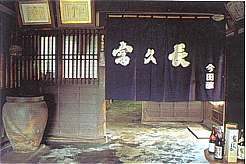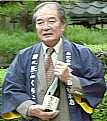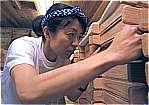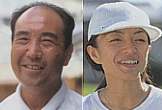|
 
Kura History
Our brewery was founded in
the first year of the Meiji Restoration, 1868, in Akitsu in Hiroshima Prefecture. Akitsu has the oldest sake-brewing history in Hiroshima, stretching back 400 years.
Akitsu, which faces the Inland Sea and has a population of about 13,000 people, once had 17 sake breweries, but now there are only three. Hiroshima, however, is still one of the most significant sake-brewing
regions in Japan, and is consistently among the top six prefectures nationwide in terms of annual sake production. Historically, the prefecture has always won many awards for its sake, and on occasion
has even swept the top three awards in the country. The sake we brew here at Imada Shuzo, called Fukucho, is very representative of this great Hiroshima style.
 The Sake The Sake
In general our sake is soft, clean and smooth, with a solid, lively fragrance. It is also a tad on the drier side. A full 60% of what we make is ginjo-shu; few places can say that. One major factor contributing to
the taste and feel of our sake is the water. Water in this region in very, very soft in comparison to most sake-brewing regions in Japan. It melts
and absorbs into the palate, taking flavor and fragrance with it, in a very unique way.
The People
 Our president, Yukinao Imada, knows the formula that goes into both making and enjoying great sake. "Water
and rice and the people that brew it are treated well and handled with care. Then, when it is ready for drinking, it must be served to people in the best environment possible. That is what makes it all work." Our president, Yukinao Imada, knows the formula that goes into both making and enjoying great sake. "Water
and rice and the people that brew it are treated well and handled with care. Then, when it is ready for drinking, it must be served to people in the best environment possible. That is what makes it all work."
 Working with him and sharing his vision is his daughter, Miho. Miho is now working intensely hard to do what few women have ever had a chance to do -- take
over a sake brewery. There is much to learn. Miho knows she must attain intimate knowledge of the sake-brewing process, and the sake itself, if she is to lead Imada Shuzo into the future. After
graduating from Meiji University, she began working for the cultural activities section in a Tokyo department store. But about six or seven years ago, she realized that "the brewery was without a successor, and I
saw no other option outside of taking over the family business." Says Miho: "It was then that sake brewing and its relationship to Japanese culture became interesting to me." Her father realized that the road
would be full of challenges. "Sake brewing is hard work, so I could not insist that my daughter follow in my footsteps and handle the business."
But now, they work together for the future of Fukucho, and for the future of sake in Japan, and in the world. Working with him and sharing his vision is his daughter, Miho. Miho is now working intensely hard to do what few women have ever had a chance to do -- take
over a sake brewery. There is much to learn. Miho knows she must attain intimate knowledge of the sake-brewing process, and the sake itself, if she is to lead Imada Shuzo into the future. After
graduating from Meiji University, she began working for the cultural activities section in a Tokyo department store. But about six or seven years ago, she realized that "the brewery was without a successor, and I
saw no other option outside of taking over the family business." Says Miho: "It was then that sake brewing and its relationship to Japanese culture became interesting to me." Her father realized that the road
would be full of challenges. "Sake brewing is hard work, so I could not insist that my daughter follow in my footsteps and handle the business."
But now, they work together for the future of Fukucho, and for the future of sake in Japan, and in the world.
Size and Special Characteristics
Our yearly production is quite small, about 1,000 koku. This amounts to about 180 kiloliters, or in other terms, 100,000 1.8-liter bottles (although
in actuality we use many different-sized bottles). This volume is perfect for the scale on which we brew, and each drop of sake can be watched with tender-loving care.
Notable Quotes
Our name, Fukucho, was given to us by a man living in the Meiji Era named Sanzaburo Miura. Miura was the man that helped make Hiroshima sake what it is today. Why? How? As mentioned earlier, the
water here in Hiroshima is very soft (i.e., low in mineral content). At first, we Hiroshima brewers were all trying to brew using methods like those in Nada, in Kobe, where the water is nice and hard. It was Miura who
realized the problem, and went to Kyoto where the water is soft. He learned the differences in brewing sake from hard water and soft water, and mastered the science. He then came back to Hiroshima, gathered
all the brewers together, and taught us what he had learned, and what we needed to know to brew the sake that we are now famous for. The rest is history. It is a great honor for us to have been given our name by
such an important individual, who will certainly live on in sake-brewing history.
Toji (Master Brewer) and Kurabito
 Our current toji is Mr. Kiyotaka Yasuhiro.
He is a toji from, naturally enough, the Hiroshima school of toji, and has been with us many, many years. His skill, experience and intuition have long helped make Fukucho sake what it is. As one example of
the fruit of his experience, he knows it is necessary to prepare the koji, the heart of the sake-brewing process that breaks starches in the rice to sugars, at just slightly higher temperatures
at our brewery due to that soft water. This gives our sake the clean tail and lively feel that it has. Perhaps his most important job now is to teach Miho all he can to prepare her for the future! Our current toji is Mr. Kiyotaka Yasuhiro.
He is a toji from, naturally enough, the Hiroshima school of toji, and has been with us many, many years. His skill, experience and intuition have long helped make Fukucho sake what it is. As one example of
the fruit of his experience, he knows it is necessary to prepare the koji, the heart of the sake-brewing process that breaks starches in the rice to sugars, at just slightly higher temperatures
at our brewery due to that soft water. This gives our sake the clean tail and lively feel that it has. Perhaps his most important job now is to teach Miho all he can to prepare her for the future!
Contact Info
3734 Mitsu Akitsucho, Higashi Hiroshima City, Hiroshima
 729-2402, Tel 81-8464-5-0003 Fax 81-8464-5-3712 729-2402, Tel 81-8464-5-0003 Fax 81-8464-5-3712
-- 81 is Japan country code; within Japan, dial 08464-5-0003 --
Email: fukucho@triton.ocn.ne.jp
Web: http://www4.ocn.ne.jp/~fukucho/ (J)
|